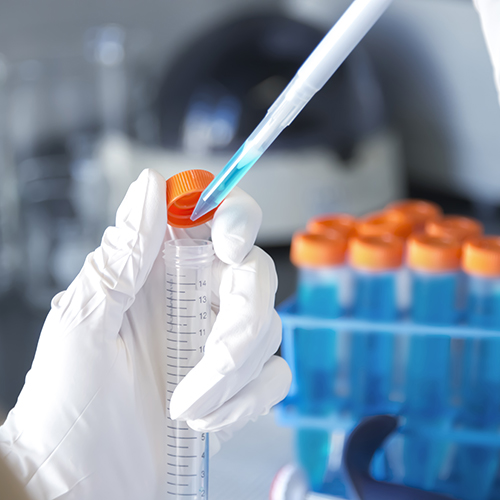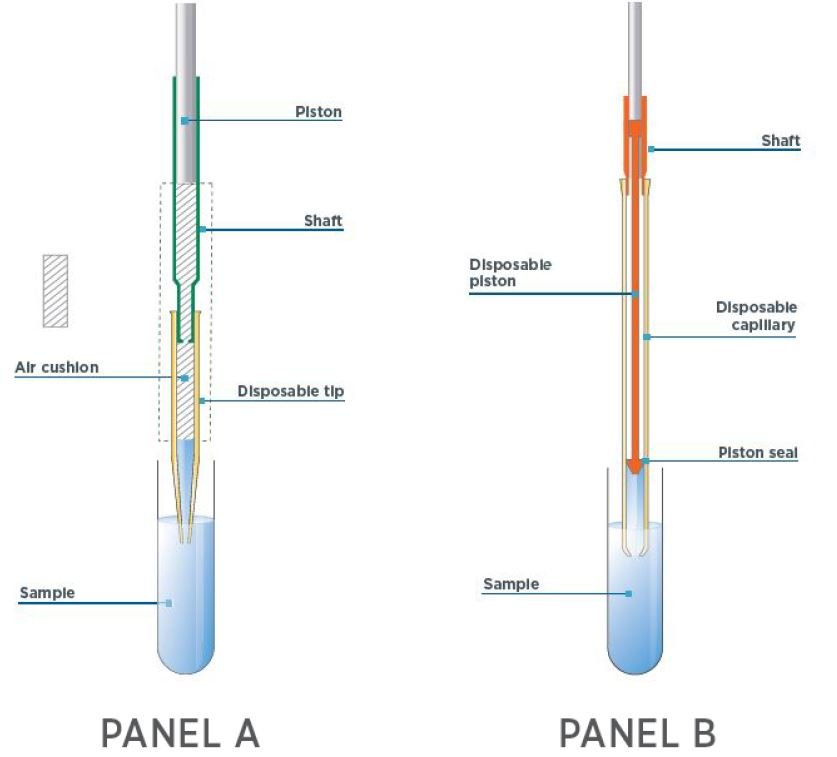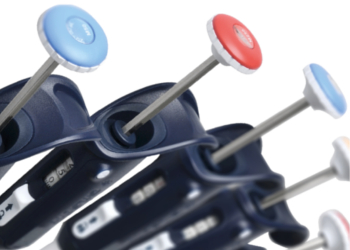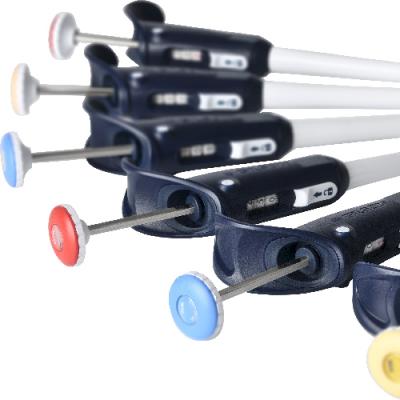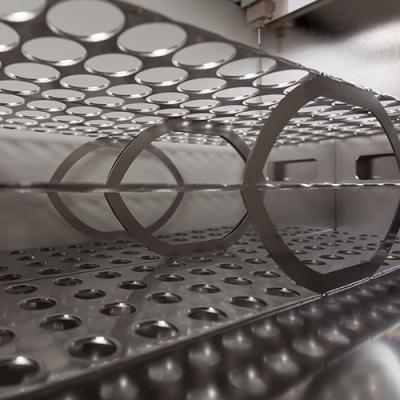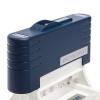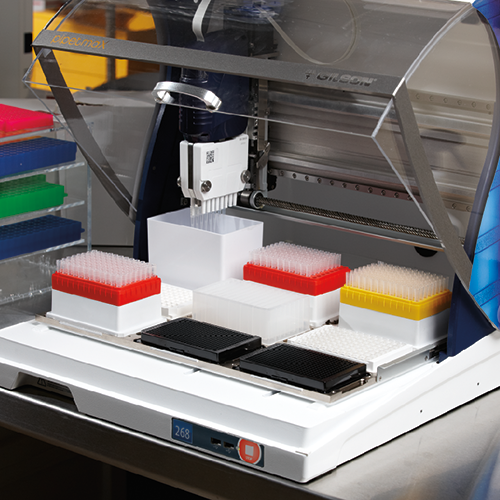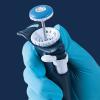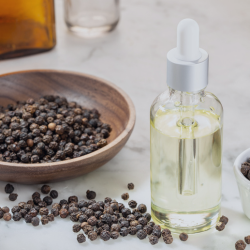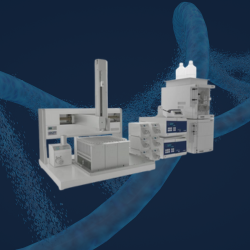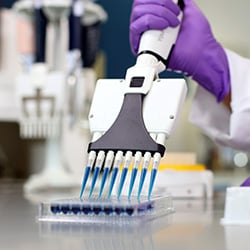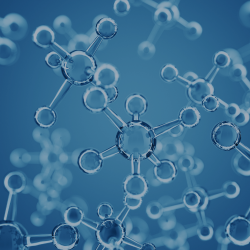When working with aqueous and non-viscous liquids, an air-displacement pipette will provide high accuracy and precision. However, a positive-displacement pipette is the best option if the assay includes viscous, volatile, hot or cold, foaming, or dense liquids.
Therefore, choosing between a positive-displacement pipette and an air-displacement pipette depends mainly on the types of fluids you’re working with. As precision, accuracy, and repeatability remain the primary concern for lab technicians and scientists, choosing the right pipette type for your assays is a vital process.
Read on to understand the differences and the benefits of positive-displacement pipettes compared to air-displacement pipettes.
Key Takeaways:
- Positive-displacement pipettes provide better results when working with non-aqueous liquids
- With the liquid in direct contact with the piston integrated into the capillary, you can increase precision and maximize repeatability with positive-displacement pipettes
- For reduced systematic errors and precise volume control with challenging liquids, a positive-displacement pipette like MICROMAN® E will provide the best results
Why Choosing Between a Positive-Displacement Pipette vs. Air-Displacement Pipette Matters
In positive-displacement pipettes, the piston used to aspirate liquids is integrated into the disposable capillary tip. Compared to air-displacement pipettes where the air cushion is between the sample and the piston, a positive-displacement pipette’s piston comes into direct contact with the sample liquid and eliminates the air cushion that the physical properties of the sample might impact.
The tight-fitting piston provides highly reproducible results regardless of the aspirated and dispensed liquid. Because the physical properties of the sample do not influence the volume delivery of the pipette, positive-displacement pipettes are ideal for:
- Hot or cold samples, where temperature affects the volume of the air cushion and impacts pipetting accuracy
- Viscous liquids like glycerol, where the liquid can stick to the tip as it’s too dense to be dispensed and reduce the volume delivered
- Ionic solutions, buffers, or mixes where air bubbles may form if aspirating too quickly
- Any volatile liquids such as acetone or methanol that can leak or evaporate when using an air-displacement pipette
- Samples that are contaminated, corrosive, or radioactive and could lead to aerosols that might create cross-contamination or damage the pipette
Figure 1. Differences between a positive-displacement pipette and air-displacement pipette
How Does a Positive-Displacement Pipette Work?
The working principles behind air-displacement and positive-displacement are different. A positive-displacement pipette doesn’t have an air cushion when aspirating a sample and is not affected by the physical properties of the sample. The absence of the air cushion offers optimal accuracy of sampling regardless of the nature of the liquid.
A positive-displacement pipette tip includes a capillary piston that directly contacts the sample, mitigating any changes in pressure or temperature inside the cylinder. As liquids with higher viscosity tend to cling to a pipette tip, the integrated capillary piston (CP) ensures that you can dispense the entire sample accurately every time.
A positive-displacement pipette’s working technique comprises of:
- Pushing the pipette onto the disposable CP and pressing the push button to the first stop
- Placing the pipette into the vessel with the CP touching the liquid
- Drawing up the sample using the CP without having any air present in the tip
- Dispensing the sample into your vessel by pressing down on the plunger
What are the Benefits of Using a Positive-Displacement Pipette?
Using a positive-displacement pipette provides numerous benefits in the lab, including a repeatable, consistent, and accurate volume delivery every time. With reduced volatile solvent evaporation, a positive-displacement pipette offers better results when working with:
- High-density solutions
- Foaming, volatile, and other problematic liquids
- Resins, fats, oils, and protein solutions with a higher viscosity
The types of assays you can conduct with positive-displacement pipettes include:
- Cosmetic production
- DNA sampling and PCR workflows
- Molecular biology and forensic science
- Environmental research and food/beverage manufacturing
A positive-displacement pipette is the best instrument to use for sample preparation for high-performance liquid chromatography (HPLC), biological fluid handling, pharmaceutical formulation, and qPCR/PCR analysis.
For an extensive list of what fields and fluid types you should consider using a positive-displacement pipette for, see this guide from Gilson.
Below is a typical pipetting workflow using positive-displacement pipettes.
Figure 2. Typical aspiration, dispensation, and ejection of a positive-displacement pipette tip
What Should You Look for When Buying a Positive-Displacement Pipette?
When deciding on which positive-displacement pipette to use, consider the MICROMAN® E from Gilson, which comes in a range of volume options. This pipette provides repeatable results when working with a range of challenging or non-aqueous fluids.
MICROMAN E pipettes come in six models ranging from 1 μL to 1000 μL and allow you to accurately aspirate and dispense viscous, dense, or contaminated liquids. Combined with the disposable CP and built-in ejector, our positive-displacement pipette can help reduce systematic errors when working with:
- Viscous surface acting solutions – Reduced systematic errors to between 0% and 1% for glycerol and 0% to 0.5% with Tween surfactant
- Volatile liquids – With acetone, MICROMAN E reduces the systematic error to 0.1%
- Hot liquids – Coffee at 75-85°C had a systematic error rate of no more than 3%, and tap water at the same temperature only reached 2.5%
The systematic error rate from air-displacement pipettes using a pre-wetting step as part of the aspiration process was much higher compared to a positive-displacement pipette.
Benefits & Features of MICROMAN E and Its Use with Your Non-Aqueous Liquid Sampling
MICROMAN E is easy to operate, ergonomically designed, and designed following ISO 8655-2 standards. Some of the main benefits you get from a MICROMAN E are:
- QuickSnap system – Pipetting with a MICROMAN E is as easy as using an air-displacement pipette. The CP can fit the pipette in only two steps with our patented QuickSnap system
- Precise volume control – Just like other volume control air-displacement pipettes, the MICROMAN E comes with volume control that prevents you from accidentally changing the setting
- Overall protection - In addition to precision and accuracy, MICROMAN E also provides triple protection from contamination when dealing with highly contaminated or hazardous samples: the pipette, the sample, and the user are protected
MICROMAN E features an improved handle shape that rests comfortably in your hand. The ergonomic design ensures you can pipette accurately without introducing user-specific errors due to fatigue or a bad pipetting technique.
Trust Gilson with All Your Precise Liquid Handling Needs
Gilson has a range of pipettes, automated liquid handling systems, and HPLC workstations available for your liquid handling needs. All our instruments are highly configurable to ensure you can find a solution that will support your sampling process.
To discuss your positive-displacement vs. air-displacement pipette needs with an expert, reach out to a Gilson representative today.
MICROMAN E Positive-Displacement Pipettes
Interested in integrating positive-displacement pipettes like MICROMAN E into your lab?
LEARN MORE

















